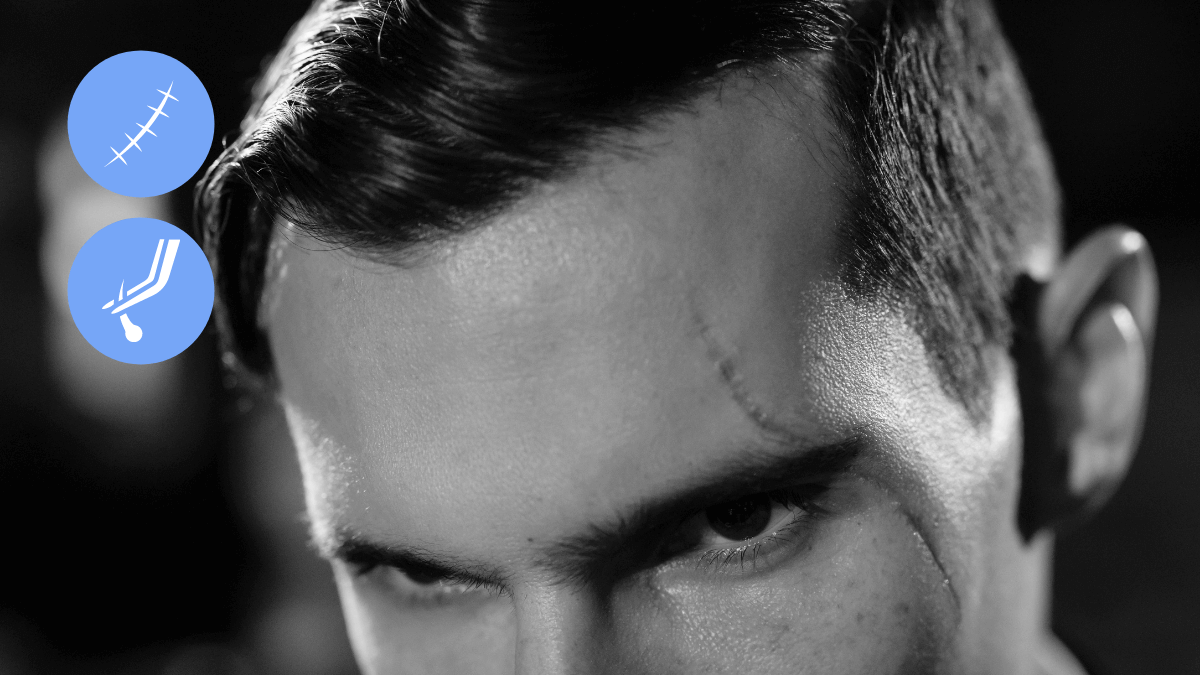TL;DR
➡ Every hair transplant naturally causes scars on your scalp, but their type, shape, size, and possibility for healing can vary based on your scalp and surgery technique.
➡ The scars naturally caused during your surgery are minimal and, with healing, will fade over time. However, whether you have larger and permanent scars depends on which surgery technique you choose.
➡ The most efficient option, in this case, is advanced FUE options such as DHI and Sapphire FUE, alongside supportive methods such as stem cells and bio-enhancements.
➡ By choosing the right clinic and surgery technique after advising your doctor about your medical history and following a proper post-surgery check-up schedule makes it possible to have no permanent scars.
As you consider getting a hair transplant to restore your hairline and get your natural look back, you’ll notice many people mention scars caused by the surgery as a huge disadvantage.
They’re not wrong.
But, before you decide once and for all, I think you should know about what kind of scarring you should expect, how long should you expect it to stay, and what you can do on your end to minimize risks:
Table of Contents
In this blog, I’ll shed light on one of the most discussed topics when it comes to hair restoration, so bear with me.
Let’s start with the basic question:
Do Hair Transplants Cause Scarring?
Yes. Yes, hair transplants can cause plenty of scarring. But the type, shape, and size of these scars or the duration they will stay on your scalp can vary a lot.
Although hair transplantation is cosmetic surgery, there is plenty of cutting and extracting that violates the integrity of your skin and causes minor injuries. These injuries naturally will end up leaving scars on your scalp.
What Causes Scarring in Medical Procedures?
Scars are a very natural part of your body’s healing process.
As your skin is damaged, in the case of a hair transplant, cut, your body wants to repair the millimetric wounds.
Once cut, there will be a rush of blood and tissue full of collagen fibers to your scalp to fill the cuts. This new tissue that is now in the place that used to be cut will have a different texture compared to other cells around it, so it will look different.
Scars usually look paler than the surrounding tissue, and in most cases, they will fade away over time to be less and less noticeable.
But, it’s pretty common for a bigger scar to still remain easily noticeable even after fading out to a certain degree, which is what you’ll have to look out for when getting a hair transplant.
Do Hair Transplant Scars Go Away?
Some do, some don’t. Most procedures end up leaving minimal scars that fade away over time to be invisible to the naked eye while some procedures can end up leaving scars big enough to force you to grow hair to hide it.
Naturally, it depends on where the scar is, what caused it, and how big it is.
And, actually, it significantly depends on the surgery technique you choose:
3 Types of Scars Caused by Hair Transplant Surgeries
Don’t get me wrong, you will get scars after a hair transplant surgery.
There is no hair transplant surgery technique at the moment that doesn’t cause any permanent or temporary scars, and the risk is always there.
So it’s not a question of whether or not you’ll be left with a scar.
It’s a question of how natural your entire scalp will look with that scar, considering the size and shape.
I’ll go over the three main types of scars caused by hair transplant surgeries, the first two of which you don’t want to have.
4mm Round and Permanent Scars on the Donor Area Caused by Hair Plugging
I know that hair plugging is not practiced as a hair transplantation technique anymore.
But it’d be good to go over this for two reasons:
1️⃣ So we can see how far we’ve progressed in terms of scarring and precision in hair transplantation.
And 2️⃣, because there are a lot of websites and social media accounts that spread false information by referring to today’s hair transplant techniques using photos of patients who had hair plugs.
So it’s good to know what hair plugging left patients with, and that it is no longer practiced.
Hair plugs were invented by Dr. Norman Orentreich in 1952 and became the first modern hair transplant technique to be practiced worldwide for decades.
It consisted of extracting 4mm-wide tissue from your donor area to directly implant into your balding areas in a series of sessions (usually 4).
Alongside causing the implanted hair to look like a doll’s hair and not producing any natural results, this outdated hair transplant method also caused 4mm-wide scars where the hair was extracted in the donor area.
Now, 4mm might sound small, but it is definitely noticeable especially if you wear your hair medium-short or shorter.
And, when you compare it to FUE’s 1mm scarring, which I’ll talk about in just a bit, you’ll see that it’s huge compared to modern techniques.
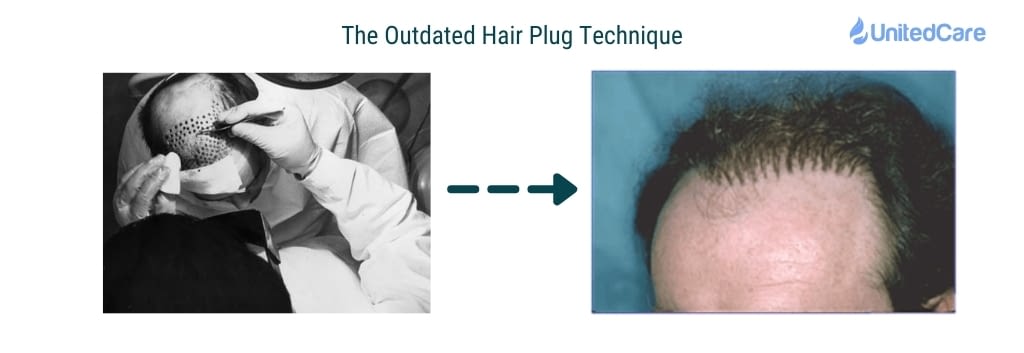
There was no way around these punch-hole scars, and the only way to hide them was to have long hair to cover them up.
Linear Permanent Scars Caused by Follicular Unit Transplantation (FUT)
The hair transplant technique that followed hair plugs didn’t do that well in the scar department too.
And actually, the scars caused by FUT are the biggest deal-breaker of the technique for the majority of patients and physicians, including me.
FUT was invented by Dr. Bobby Limmer in 1988, and it quickly replaced hair plugs because of the natural results it produced in the recipient area and its ability to restore any hairline in just a single session.
It became the gold standard…
…but it wasn’t perfect.
You see, in a FUT surgery, the surgeon removes a strip of tissue directly from the back of your scalp and after that, they extract the hair grafts from the tissue. This is then followed by the implantation of individual hair grafts into your recipient area.
Now, at the site where this donor tissue is cut, things won’t be looking good for, well, ever.
The first issue is, that it will leave a scar that will fade away only to a certain degree because there was a huge cut at this site.
And even if it fades away significantly, the scar will still be very visible simply because all the hair follicles in this area were harvested and it is now a bald spot.
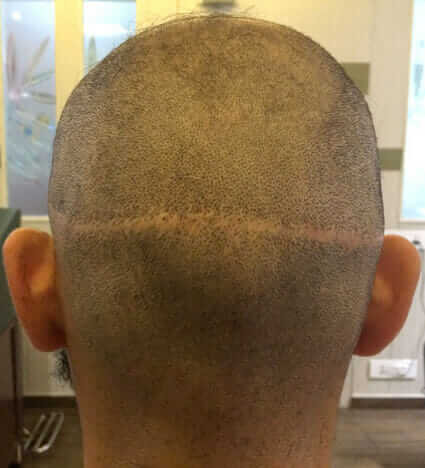
So even though it might end up being more of a bald area than a complete scar, it’ll still look very unnatural and noticeable.
Again, just like the scars from hair plugs, the main option is to hide this scar under long hair.
But, additionally, it’s not uncommon for FUT patients to undergo an FUE surgery shortly after their first surgery, to implant hair into this linear scar in hopes of trying to make it better, which sometimes works.
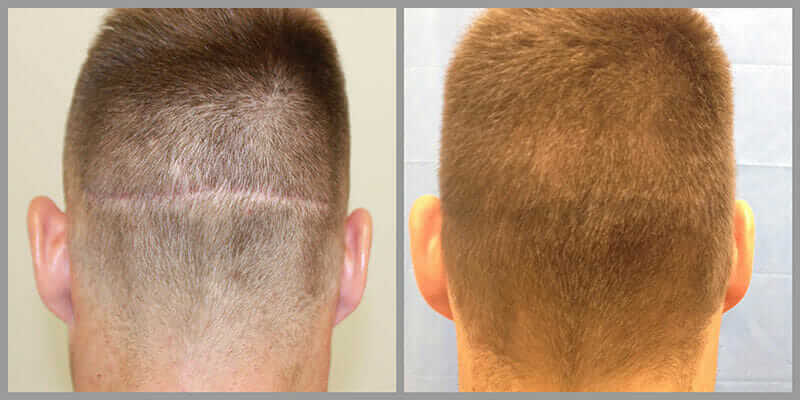
0,7mm to 1,1mm Round Scars Caused by Follicular Unit Excision (FUE)
The last type of scars, and frankly your best option, is the millimetric round scars caused by FUE surgeries.
FUE works in a similar way to hair plugging when it comes to extraction of hair grafts, but it only punches around a single graft in diameter of 0,7mm to 1,1mm, 4 times smaller than hair plugs.
FUE surgeries and their advanced variations make up two-thirds of all hair transplant surgeries on earth, and the main reason it is considered the best option today is the least amount of visible scarring after the surgery.
You’ll end up with scars that are 1mm in diameter on average, all over your safe donor area in an even fashion.
The downside is, that these scars will still be visible if one were to examine them closely.
But the upside is, these scars affect your overall appearance very little, and if you go with a smaller graft count therefore less harvesting, you can wear your hair very short and still pull off a natural look.
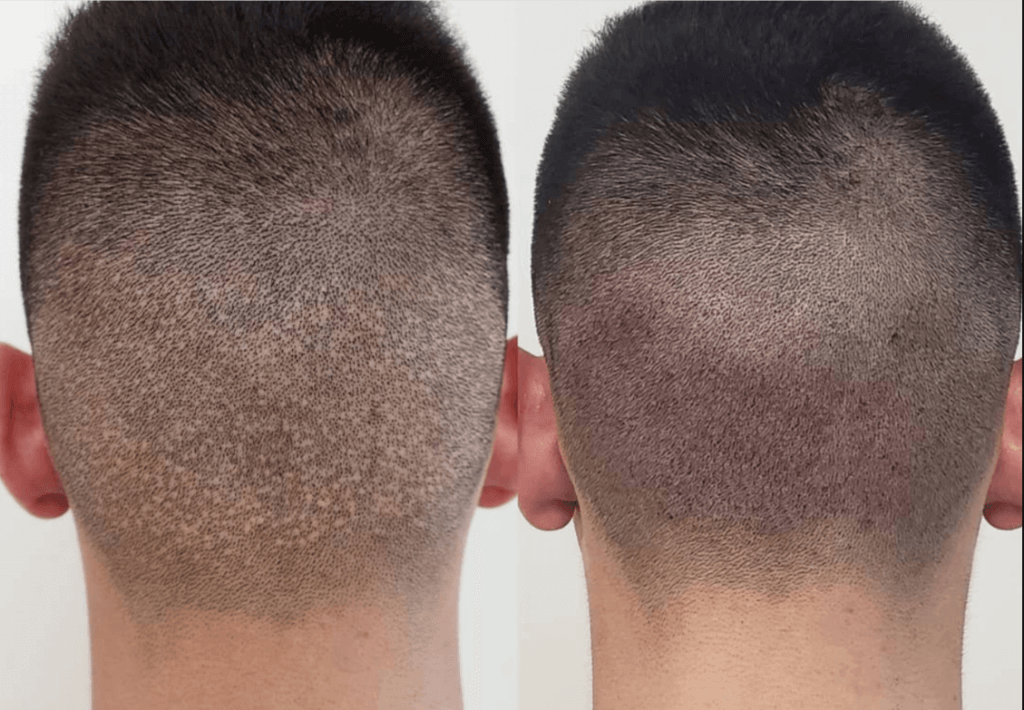
Especially once FUE scars have healed, they will be much less noticeable compared to FUT and hair plugs.
But keep in mind that post hair transplant care of both your donor and recipient area is important for quick and efficient healing of scars.
Minimizing Scars from a Hair Transplant for the Natural Look
Clinics that practice FUT or more traditional variations of FUE usually have inexperienced physicians onboard and a desire to cut costs.
It is imperative to work with a clinic and a staff that puts your health and the success of your hair restoration before anything else, like UnitedCare.
We’ve started UnitedCare as a dermatologist duo with over 20+ years of experience, to make sure our patients have the success stories they always wanted. We aim to help each and every patient restore their natural look.

We use advanced FUE variations such as DHI and Sapphire FUE combined with the latest methods such as bio-enhancements to ensure patient health, quick recovery, and outstanding results.
We’re just a click away: 👇
Restore your natural look with UnitedCare’s experts dermatologists.
UnitedCare ensures that you avoid any potential side effects with a holistic approach to FUE surgeries:
Frequently Asked Questions (FAQs)
How long do hair transplant scars last?
The initial distinct look of a scar caused by a hair transplant surgery should heal in less than three months and fade out a little, but there is a high probability a less noticeable and permanent scar will stay on your scalp after the operation. However, the shape and size of this scar can change based on your hair transplant technique.
Are scars from a hair transplant visible?
Mostly, yes; but how visible a scar is depends on the hair transplant method you’ve used. With the now unused hair plugging technique, you’ll have 4mm-wide round scars around the donor area while with the FUT technique, you’ll have one big linear scar in the middle of the back of your head which is highly visible. However, in the FUE technique, you’ll be left with minimal scars that are only 1mm-wide in diameter, which should only be visible when examined closely.
Should scars be a deal-breaker for my hair transplant?
Most experts including myself would agree that FUT is not preferred by top clinics and surgeons because of the big linear scar it leaves on the patient’s scalp; so yes, larger scars should definitely be a deal-breaker for your hair transplant. But, if you go along with a more advanced FUE variation, your scars will drop to a very small size that will be hardly visible to the naked eye, in which benefits should outweigh the risks.
